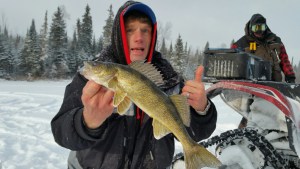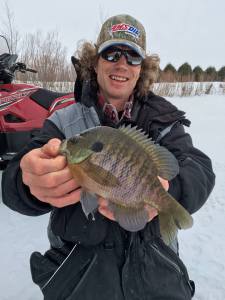7 Expert Ice Fishing Tips with Pro Angler Pete Maina
Before you embark on your first ice fishing trip of winter, check out these tips from professional angler Pete Maina, one of Outdoor Life magazine’s “20 Best Anglers on the Planet.” Based in Hayward, Wis., one of North America’s best fisheries, Maina boasts decades of experience landing musky, walleye, bass and just about every other species of fish, both through the ice and from the boat.
Safety First
Step one: Always ensure the ice is safe. “Unfortunately, I’ve lost a couple good friends falling through the ice,” said Maina. He offers the following guidelines for ice thickness:
• 3” for walking
• 5-6” for ATVs/snowmobiles
• 12” for trucks
Invest in a pair of ice picks, too. They drape around your neck and, if you go through the ice, you use the picks protruding from each handle to gain a purchase on the ice and pull yourself to the surface. They’re only as effective as the person using them, though.
“I bet half the people who go through the ice wouldn’t be able to pull themselves out,” said Maina. For that reason he recommends another safety tool: “Ropes, ropes, ropes,” he said. “I can’t say enough about the importance of having several ropes on hand if someone falls through.”
Understand Water Currents
Unsafe ice can be easy to spot. But sometimes water currents erode ice from underneath, making it difficult to determine safety. Study the system to understand where the current might pose a problem. Ask local bait shops or the DNR. River systems obviously present current that can make ice unsafe. But lakes, too, have currents that can vary from area to area. “Whenever you hear about a knowledgeable angler going through the ice, current often is to blame,” said Maina.
Check Your Reels, Lures and Line
Check the condition of your fishing line. If you see nicks or weak spots, change it. Maina recommends changing your leader every year. “Use a good fluorocarbon leader,” he said. “I want five feet of leader on my lines so there’s plenty available for tying on new lures and cutting. When the leader becomes less than two-and-a-half feet, change it.”
Check reel condition and lubricate. AMSOIL MP makes an excellent reel lube. “I use AMSOIL MP for a lot of things to clean and lubricate,” said Maina. Test the drag, too. Pull the fishing line and check for smooth resistance with no catching.
The same procedure applies to your tip-ups as well. In addition to checking the line, lubricate the spool to ensure the line flows easily and won’t disrupt a strike.
Finally, make sure all your hooks are clean and free of rust.
Prepare Your Electronics
Like every other aspect of life, electronics have redefined fishing. Mapping applications allow you to walk right to structure and start drilling holes even if you’ve never been on the lake before.
Whether it’s your smartphone, flasher or sonar, electronics require charged batteries. Ensure you adequately charge the batteries before you head out. If you’re using a flasher or sonar, make sure the wires are in good shape, too.
Choose a Versatile Fishing Spot
Set-up in a location that offers ready access to multiple lake features. For example, early in the season, Maina likes to choose a spot 
“Work the shallow edges, then check the deep water,” he said. “I’ll most likely find fish in the early part of the season on top of structure and on the edges. Sometimes I’ll find them suspended maybe six feet down or so over deep water, too. Just set-up where you can access several areas without moving too much.”
Experiment with Different Types of Bait
You never know what bait or presentation will entice the fish to strike on any given day. Try all kinds of live and artificial bait. “For my stationary lines, I like to use a few different types of live bait. I’ll use different sizes of minnows, too,” Maina said. “If it’s available, use dead bait too, especially for northern pike. The bottom line is, prepare your equipment so you can use several presentations – spoons, maggots, jigging baits, a variety of colors of plastics – try them all.”
Capitalize on Weather Changes
Fish are especially finicky in the winter. Use the changes in weather patterns, when fish are more likely to be active, to your advantage. “Watch for changes in wind direction or barometric pressure,” Maina said. “If the weather report indicates a front passing through at, say 2:00 p.m., be out there fishing at that time.”
What if the weather remains steady with no changes? “That’s when solunar tables make a huge difference,” Maina said. “Fish during major and minor times. But weather trumps everything. When abrupt changes occur, that’s when you want to be out there.”
You don’t have to be a pro to have a great day ice fishing. Sit back, enjoy your time and be safe.







